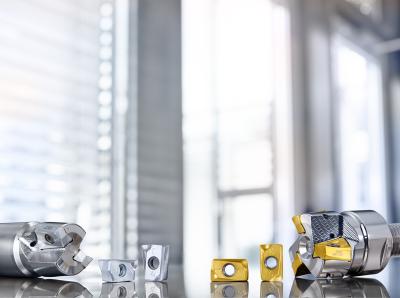
For manufacturers who struggle to achieve superior part surface finishes without high machine power consumption, Seco Tools has expanded its industry-leading line of square shoulder milling cutters with the new Double Turbo. The cutters improve roughing operations and reduce power consumption in steel, stainless steels, cast iron and high-temperature alloys with an advanced cutter geometry. For the highest level of productivity, the tools utilize double-sided inserts with four cutting edges and state-of-the-art Seco Tools milling grades.
The Double Turbo meets the needs of both job shops and mass production facilities. This system features a highly accurate geometry with the most positive helix angle possible to reduce the likelihood of surface mismatches and enable impressive 90-degree angle accuracy. With such precision, finishing cycle times are significantly shortened or, in some cases, completely eliminated. Double Turbo cutters are available in 19 metric variants ranging from diameter 40 mm to 125 mm and 16 inch variants ranging from 1.50" to 5".
The ZOMX16 inserts have high, positive geometries for effective chip evacuation and reduced cutting forces. These features minimize vibrations for extended tool life and smooth surface finishes. The double-sided design provides significant cost-per-edge savings. The ZOMX16 inserts include two geometries, ME10 and M12, and two radii, 0.8 and 1.6. Both PVD and Duratomic® CVD grades are available.
The Double Turbo square shoulder cutter design uses materials and resources with greater efficiency, resulting in a reduction of greenhouse gas emission (CO2) for a more sustainable and responsible choice.
Contact Details
Related Glossary Terms
- alloys
alloys
Substances having metallic properties and being composed of two or more chemical elements of which at least one is a metal.
- chemical vapor deposition ( CVD)
chemical vapor deposition ( CVD)
High-temperature (1,000° C or higher), atmosphere-controlled process in which a chemical reaction is induced for the purpose of depositing a coating 2µm to 12µm thick on a tool’s surface. See coated tools; PVD, physical vapor deposition.
- gang cutting ( milling)
gang cutting ( milling)
Machining with several cutters mounted on a single arbor, generally for simultaneous cutting.
- helix angle
helix angle
Angle that the tool’s leading edge makes with the plane of its centerline.
- milling
milling
Machining operation in which metal or other material is removed by applying power to a rotating cutter. In vertical milling, the cutting tool is mounted vertically on the spindle. In horizontal milling, the cutting tool is mounted horizontally, either directly on the spindle or on an arbor. Horizontal milling is further broken down into conventional milling, where the cutter rotates opposite the direction of feed, or “up” into the workpiece; and climb milling, where the cutter rotates in the direction of feed, or “down” into the workpiece. Milling operations include plane or surface milling, endmilling, facemilling, angle milling, form milling and profiling.
- physical vapor deposition ( PVD)
physical vapor deposition ( PVD)
Tool-coating process performed at low temperature (500° C), compared to chemical vapor deposition (1,000° C). Employs electric field to generate necessary heat for depositing coating on a tool’s surface. See CVD, chemical vapor deposition.
- stainless steels
stainless steels
Stainless steels possess high strength, heat resistance, excellent workability and erosion resistance. Four general classes have been developed to cover a range of mechanical and physical properties for particular applications. The four classes are: the austenitic types of the chromium-nickel-manganese 200 series and the chromium-nickel 300 series; the martensitic types of the chromium, hardenable 400 series; the chromium, nonhardenable 400-series ferritic types; and the precipitation-hardening type of chromium-nickel alloys with additional elements that are hardenable by solution treating and aging.

